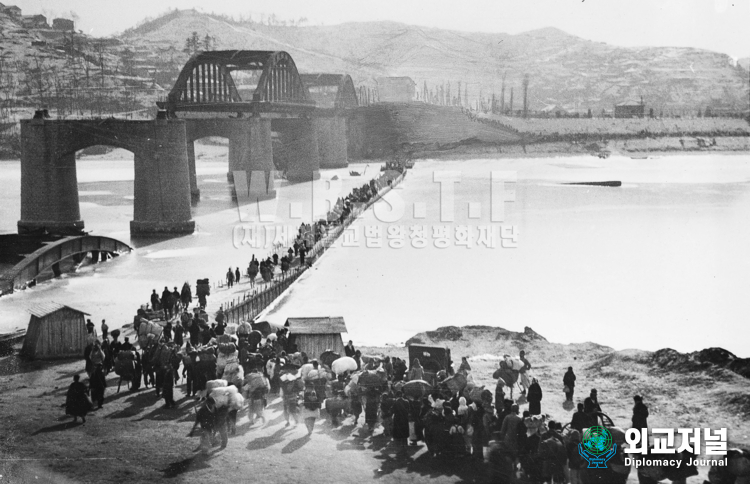These photos , discovered through cooperation from the New York UN headquarters during the period of IAEWP and NGO-UN activities from 1997 to 2004, by the publisher of Diplomacy Journal, have unearthed around 350 photos. Some of these photos will be publicly released along with five undisclosed Korean War videos to commemorate the 73rd anniversary of the 6.25 Korean War.

In the Korean War, a total of 1,312,836 casualties, including 415,004 Korean military fatalities, were recorded. The US military sacrificed a total of 36,940 young individuals, including 33,665 combat fatalities and 3,275 non-combat fatalities.

Furthermore, in 103,284 operations, 92,134 individuals were wounded, and a total of 1,789,000 US soldiers participated in the Korean War from June 25, 1950, to July 27, 1953. There are still 8,176 missing persons. The UN forces suffered a total of 16,532 casualties, including 3,094 fatalities.
The online exhibition can be found on the websites http:// djournal.co.kr and http://www. wbstf.co.kr.

▲ An endless column of refugees cross the provisional brodge over the Han River built beside the damaged span of the
bridge. Korea, December 1950

CIVILIAN LIFE REVIVES IN KOREA
Two monks, father and son, keepers of a Buddhist temple in South Korea which survived the war with only slight damage. Five hundred communist troopsswere billeted in it at one time. Their temple dates from 982 A.D. and is maintained by revenue from the lands it owns, receiving one-third of the crop planted on them by local farmers. It also receives contributions from its parish of 100 families. In the parish of this temple only 10% of the people are Buddhist, About the same number are Christian and the rest are Atheists. KOREA: 14 October, 1950.

Please credit UNATIONSDES SOLDATS ETHIOPIENS ARRIVENT EN COREE
En November 1950, le Secretaire general de l' O.N.U. etsit svise qu' un corps expeditionnaire ethiopien -1069 officiers et soldats irait bientot se joindre aux Forced des Nations Unies en Coree. Cette photographie fut prise sur les quais d'un port du sud de la Coree. en mai dernier, le jour de l'arrivee du corps expeditionnaire. On y voit SYNGMAN RHEE, President de la Republique de Coree, agiter son chapeau en signe de bienvenue aux Ethiopiens tandis que le transport de troupes s' approche du quai. Ala droite du President, l' Amiral SOHN,de la Marine de la Republiqus de coree.

DEVASTATION IN KOREA
Orphans in the rubble of Inch on. South Korea. September 1950.

SOUTH KOREA FROM RUIN TO REVIVAL RECONSTRUCTING
After three years of fighting and destruction, the Republic of Korea is trying of rise io its feet again, but the road from ruin to revival is strewn with difficulties. Cities and villages have been destroyed, communications disrupted and there are great shortages of homes, food, clothing and fuel. The United Nations has set up the U.N. Korean Re-construction Agency (UNKRA) to help in the basic rebuilding of the country. Financed by voluntary contributions from governments, it works closely with the Government of the Republic of Korea and cooperates with other organizations having objectives similar to its own. Set up jointly by UNKRA and the american Korean Foundation, the Tongnae Physical Rehabilitation Center, near Pusan. does vital work in rehabilitating the halt and the maimed. This photograph shows Sgt. SIM, an inmate of the Center, who designed and built an artificial limb with a special swivel knee that enables him to squat in the traditional Korean way. PUSAN, SOUTH KOREA, 1954.

AFTERMATH OF THE WAR IN KOREA
These war orphans, found wandering in the ruins of Seoul, are being taken to the Seoul Civic Orphanage by Mr. Uit D. BOGGAARD, U.N. Welfare Officer on the staff of the Unified Command. Korea. October, 1950.

AFTERMATH OF THE WAR IN KOREA
Flying the Communist forces, a long line of Korean refugees struggles southward through the snow. They are forced to keep off main roads, to avoid hindering military traffic. Korea, January 1951.

UNKRA'S HELP TO KOREA : HOUSING
To replace dwellings destroyed during the fighting in Korea and by sub-sequent fires, to care for refugees from North Korea and to meet the normal increase in population, a million new housing units are required in South Korea, where approximately 5,000,000 persons are presently living in emergency shacks such as those shown in this photograph. To meet the pressing need for housing, the ROK Government in conjunction with the U.N. Korean Reconstruction Agency

REVUIDING SOUTH KOREA
In the war-shatterec Republic of Korea there is a great need for large-scale aid from outside. Three years of fighting and destruction have left great shorgages of food and clothing. At least 1,000,000 new homes are needed. About one South Korean out of every four now lives in a makeshift shelter. Hearths in the home and furnaces in insustry do not burn brightly. They lack fuel. General living standards are low and the country is desperately short of money to restore and expand the production of the necessities of life in its factories, mines and farmlands. But the country is trying to rise to its feet again, though the road to revival is a hard and difficult one. This photograph shows one of the main thorughfares in Seoul. Seoul, Korea. August 1954.






